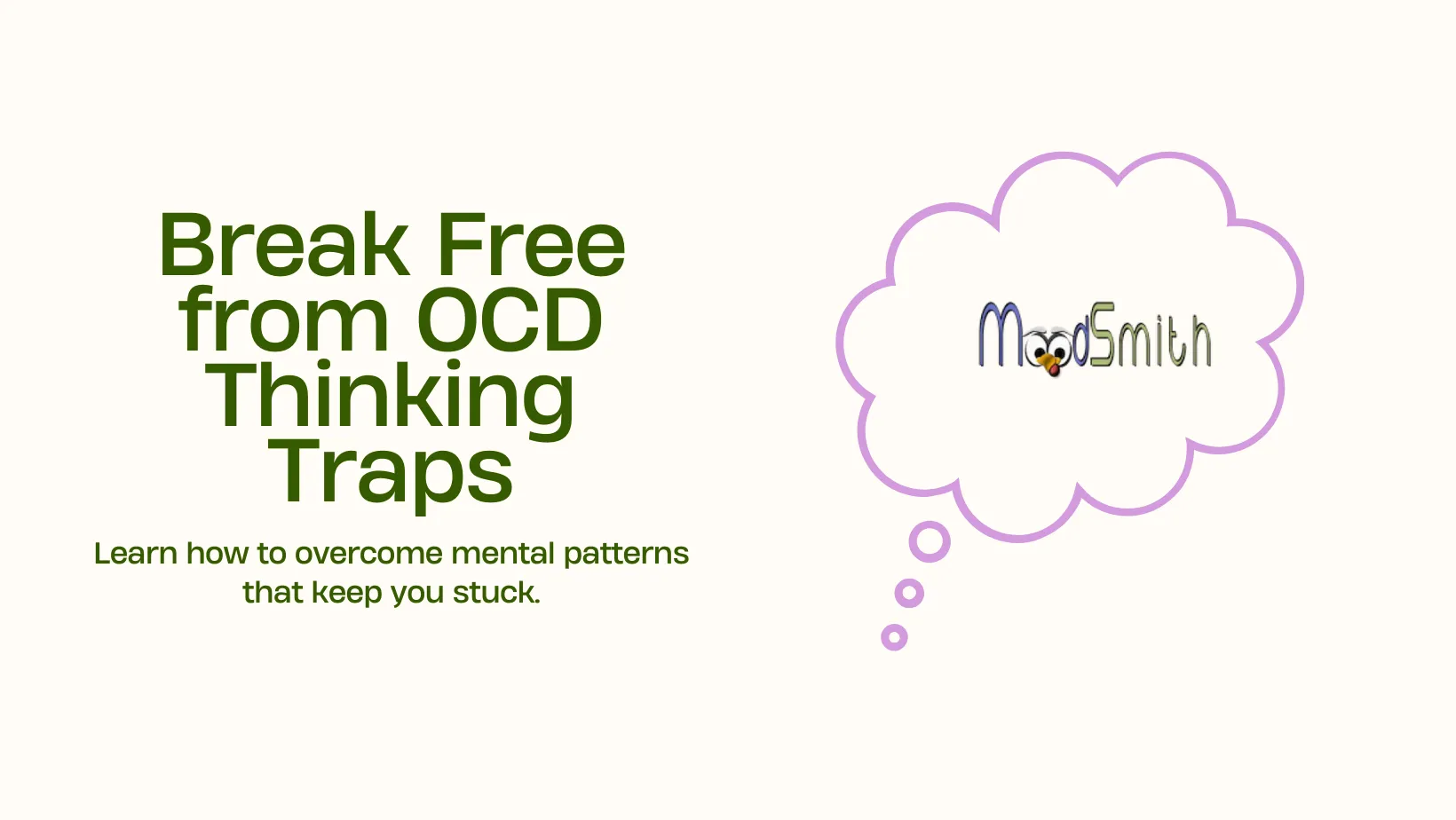If you have obsessive-compulsive disorder (OCD), the main thing that keeps you stuck in your condition is thinking traps or cognitive distortions, to give them a formal name. The ‘ thinking traps’ can exacerbate or maintain the symptoms of the disorder.
I’ve written quite a bit about distortions, and I’ll list a few related articles below if you want to reference them.
Today I want to spend some time talking about how these styles of thinking that keep in stuck in the cycle of OCD.

What is the cycle of OCD?
You might have come across the phrase, the cycle of OCD before, and it’s worth explaining what that is before I go on. The image below shows the cycle where
- you get an obsession
- it makes you anxious
- you carry out your compulsion
- You feel better for a while
but then you get an obsession, and it starts all over again
If your compulsions were the cure, there would be no cycle as whatever your ritual is would have solved the problem, but as you know only too well, it only gives temporary relief from the anxiety created by your thoughts. To feel better properly, you need to find an exit, something that gives more than short-term relief, and in order to do that, you need to know what is keeping you on this merry-go-round of unhelpful behaviours and one of the answers is understanding ‘thinking traps.’

Thinking traps keeping you stuck could be
- I must perform my compulsions or something bad will happen
- before I do anything, I need to know for sure, as in 100% sure that nothing is going to happen
- my compulsions are helping me
Let’s look at these traps individually starting with I must perform my compulsions or something bad will happen. Unless you have gone a considerable amount of time without ritualising you will not know if it is your compulsions that are helping or not. In my years of working with people with OCD I find this quite ironic, as do my clients, when I point it out. You won’t do anything unless you are 100% sure nothing bad will happen, but yet you are happy to keep going with your compulsions without knowing 100% for sure if they are helping.
The only way to know for sure if stopping compulsions result in bad things is to put them to the test. I have written an article on this before and I give instructions on how to set up this test. I recommend reading it and seeing for yourself.
The second trap of needing absolute certainty is quite tricky. People with OCD do not do well with uncertainty and doubt, so how to work with it? The answer is quite simple in theory but more difficult to carry out; you have start to trust your own senses. For example, (this is one of my things I do!) if you lock the door and need to go back and check it. Use you senses,
- I watched myself lock the door
- I felt the key in my hand
- I heard the sound of it locking
Then tell yourself that what you are experiencing is the ‘doubt’ that is common in OCD, and do your best to walk away.
Finally, what to do if you think your compulsions are helping you.
Straight out of the bat, I can tell you that they are not helping you, if they did, you would have found the cure to your OCD after trying a compulsion, but, referring the my OCD cycle image above, you end up getting stuck in the cycle. The best way to over come this is to practice not ritualising and exposure response prevention (ERP) is the model that will help you here.
Cognitive-Behavioral Therapy (CBT) and Exposure and Response Prevention (ERP)
Cognitive-Behavioral Therapy (CBT) is a highly effective treatment for OCD. It involves identifying and challenging distorted thoughts. It also involves developing healthier thinking patterns and coping mechanisms.
Exposure and Response Prevention (ERP) is a specific type of CBT. It involves gradually exposing the individual to their feared thoughts or situations. The goal is to reduce the anxiety associated with these thoughts or situations.
ERP also involves preventing the individual from engaging in their usual compulsions. This helps break the cycle of obsessions and compulsions.
Both CBT and ERP require the guidance of a trained mental health professional. They are typically delivered in a structured format over several sessions.
Mindfulness and Reframing Techniques
Mindfulness techniques can be beneficial in managing OCD thinking traps. They involve staying present and focused, rather than getting caught up in intrusive thoughts.
Mindfulness can help individuals observe their thoughts without judgment. It can also help them recognize when they’re falling into a thinking trap.
Reframing techniques involve challenging distorted thoughts. They also involve replacing these thoughts with more realistic and balanced ones.
For example, an individual might reframe the thought “If I don’t wash my hands exactly seven times, I will definitely get sick” to “It’s unlikely that I will get sick if I don’t wash my hands exactly seven times.”
Both mindfulness and reframing techniques can be practiced independently. However, they can also be incorporated into a broader treatment plan, such as CBT or ERP.
When to seek professional help
If you find that you cannot get your OCD under control I recommend meeting with a licensed mental health professional who specialises in OCD and get expert help. Your local doctor should be able to recommend good therapists in your area if you don’t know where to start. The important bit, is to just start, whether that is reading literature here on MoodSmith or IOCDF or seeking professional help, there are things you can do to help you find the exit out of the OCD cycle.
